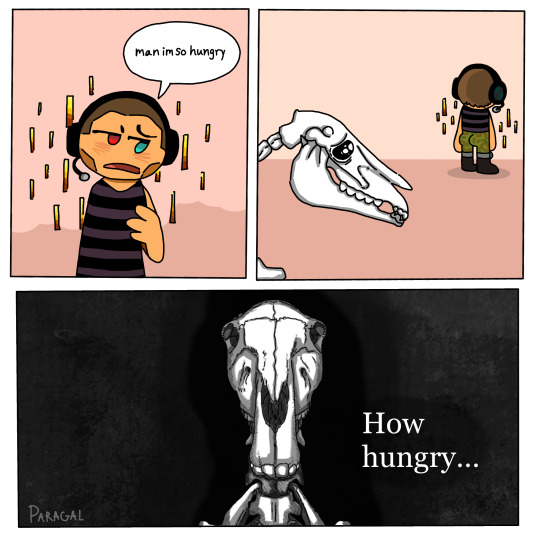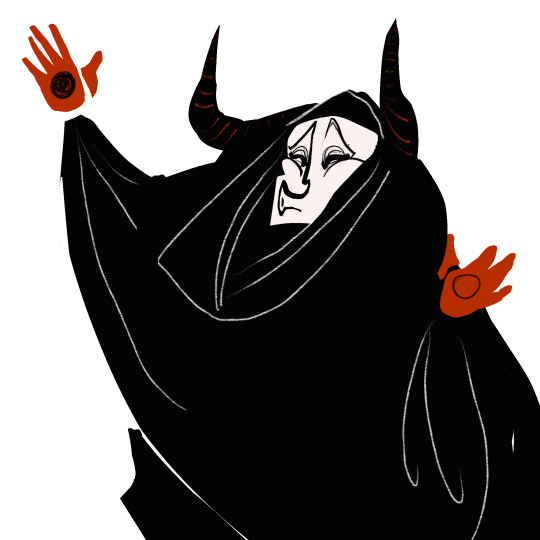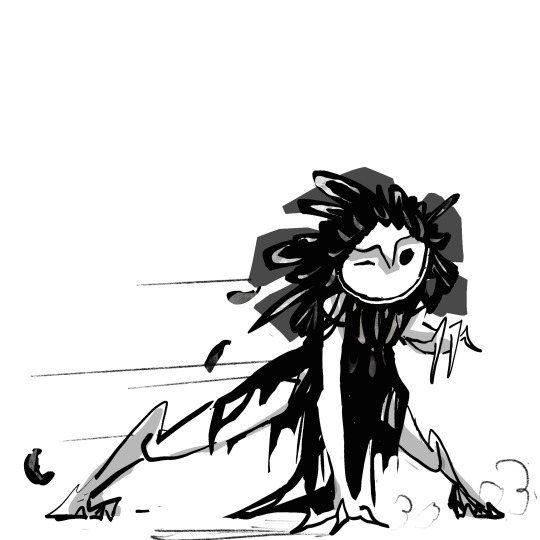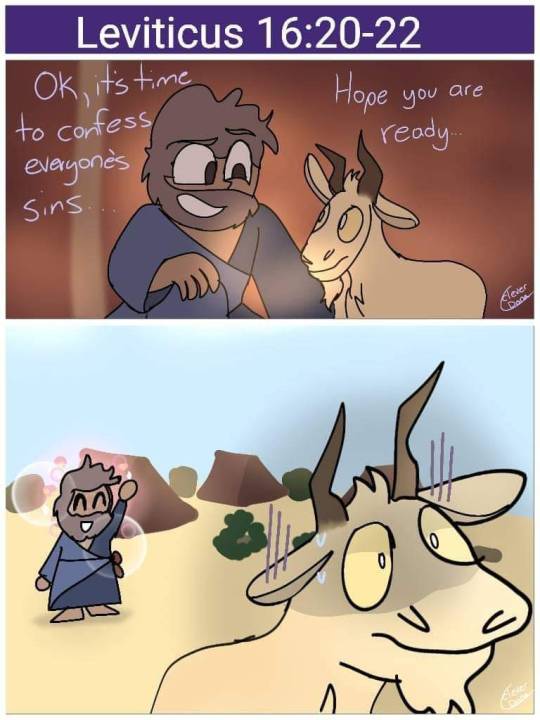#original biblical studies
Text

#christian blog#jesus#bible reading#christian doctrine#bible scripture#biblical#glorytogod#bible#faith in jesus#bible study#biblestudy#bible verse#bible devotions#bible prophecy#bibledaily#bibleposting#bible quote#bibleversoftheday#biblical art#christian bible#original biblical studies#biblical studies#biblical scripture#scripture#holy bible#holy spirit#share the gospel#spiritual warfare#spirituality#God's kingdom
172 notes
·
View notes
Text

Day 5: I think everyone should love and cherish Mr. Bones from Origins SMP
#manifold may#jack is going to gnaw on mr bones’ femur like a dog#I wouldn’t put it past him since he can eat like everything due to being a blaze#and he always loses all his good food by dying a trillion times#not totally in love with the colors in this one but it’s not my fault#jack manifold is so stupidly orange I can’t do a direct color drop without wanting to scream#augh skulls are so fun to draw#the last time I drew a horse skull it was a Georgia O’Keefe study when I was like 11#now 8 years later ive moved on from classic American southwest oil paintings#to drawing a minecraft character with a big ass threaten to eat his horse#upgrades people upgrades#tried to make origins jack somewhat biblically accurate but included my own silly little aspects#osmp jack doesn’t have sleeves because…. ohoho… I have to show you all my little design for him…….#origins smp#origin smp#origins smp fanart#mcyt#mcyt fanart#osmp#osmp jack#o!jack#jack manifold#jack manifold fanart#o!jack fanart#o!jack manifold#o!jack manifold fanart#jack manifold art#origin smp fanart#origins jack#skull tw
332 notes
·
View notes
Text



Evening monster drawings
#monsters#character design#quick sketch#monster#monster lovers#monster design#concept design#forest fae#forest core#forest witch#witch#artists on tumblr#illustration#sketch#character art#art#original character#digital art#digital sketch#digital painting#art study#biblical angst#dark fae#fae folk#fae core#swamp thing
13 notes
·
View notes
Text
feeling like a real "well, actually-" bitch reading articles for my capstone that have only done surface digging into the ugaritic texts ahdhsjhs they make so many mistakes and parrot some common misconceptions and I'm sitting here like

#religious studies rambles#this man is calling yamm a sea serpent and saying baal isn't the son of el and I'm like aaaaahhHHHH#it looks like he just read the origins of biblical monotheism (good text) and that's it#and I'm like that's a great book for this but. it's a cursory glance.#you gotta read what the translators say bc they can offer insight into what's going on and not Just their interpretation
7 notes
·
View notes
Text

Aaron confesses the people's sins to a goat
#funny#digital drawing#bible story#bible study#biblical art#biblical figures#bible verse#bible scripture#bible#original comic
5 notes
·
View notes
Note
Your posts on faith & science reminded me of this other post on angels being anything that carries out a message or mission for God, and that these can include forces of nature. I have it reblogged on my own blog here: https://mademoiseli.tumblr.com/post/667665278990155776/copperbadge-headspace-hotel-lazarusemmaan. I wonder have you come across it, and what's your take on something like that?
Huh. Okay. For others' reference (and so that I can look at while I write), here's a screenshot of the post in question:

So I tend to think that contemporary popular culture takes way too many liberties with Biblical angels, ironically often in the name of adhering closely to what's "Biblically accurate." This is... not that, but it kind of feels like it's coming from the same place? "Wow, angels are neat; wouldn't it be cool if they...?"
Don't get me wrong, I definitely understand the poetic appeal of this idea. The concept of the Angel of Glycosidic Linkages or somesuch is thought-provoking and compelling. My biggest problem is that this just. Isn't in the Bible? And note that Midrash=\= Biblical canon in Christianity, since Rabbi Abramowitz mentions it.
I mean, for one thing I think that "anything that carries out a mission from God" is way too broad a description for what angels are/do. A quick search on Gospel Coalition defines angels as "spiritual beings who were created by God before the world was created for the purposes of worshipping him and accomplishing his will." I'd elaborate that they're created to declare and reflect God's glory, albeit in a different manner than humans are.
That's just fundamentally different than what natural forces were created to do: to act on the world in predictable ways as part of a system. Natural forces are awesome I think in large part because they are regular, measurable, and mundane. They're not miraculous in the extraordinary sense; they just are. God made rules for the universe and He follows His own rules. That's super cool! He sustains the universe in every moment, but equally he set in motion processes that can sustain themselves when you view the world as a closed system. Again, pretty awesome!
I'm not discounting the possibility that angels are involved natural phenomena in some capacity or another; the Bible doesn't tell us as much about angels as I think most of us would like to know. But given what God has revealed about angels, I don't see this idea anywhere in the text of Scripture. Thus, I think conflating angels with natural forces is more likely to cause theological error than it is to provide any real insight.
Plus like. As compelling an image as the Glycosidic Linkages Angel is, aren't glycosidic linkages cool enough on their own? Don't they already declare the glory of God without there needing to be an angel involved?
#can you tell i'm doing a lot of biochem this semester lol#idk i'm at best an angel enthusiast i've never made a serious study#i feel confident in this response but i do very much see why the original post makes for a compelling image#and others feel free to chime in#especially if you /have/ made a theological study of Biblical angela#ask me hard questions#glory to god in the highest#all truth is god's truth
16 notes
·
View notes
Text
What is the Tree of Life (Etz Chaim)? The term has its origins in the biblical story of the Garden of Eden and has come to be used frequently in Jewish life from My Jewish Learning
#My Jewish Learning#What is the Tree of Life (Etz Chaim)?#The term has its origins in the biblical story of the Garden of Eden and has come to be used frequently in Jewish life#Jewish Studies#Natural Connections#The Trees Speak#Bookshelf#Tumblr Staff Has Ruined Links Now And I Hate Them For It
1 note
·
View note
Text

Learn Biblical Hebrew from Aleph to Tav
www.laciniagallery.com/aleph
#art#jesus christ#jesus is coming#jesusislord#linguistics#jesussaves#original art#traditional art#torah#writers#hebrew#biblicalhebrew#biblical art#biblical studies#biblical scripture#bible#salvation#resurrection#psalms#christianity
0 notes
Text

#self-focus#Sin origin#biblical discipleship#Bible Study#discipleship#body of christ#kingdom of god#kingdom builders#church#Truth#Ministry#ecclesia#End of days#Kingdom warfare#Freedom#Lasting Freedom
0 notes
Text
Me: I don’t deny your identity. I acknowledge Palestinians exist today.
Them: Jesus was a Palestinian, not a Jew!
Me: Well, no - he was a Jewish rabbi. He had a bris, kept Shabbat, kept kosher, & his “Last Supper” was a Passover Seder. Besides, nobody would be called “Palestinian” for ~1,900 years after #Jesus died.
Them: Jews are #Khazars with no history in Palestine!
Me: Well, no - millions of DNA samples have now scientifically proven that Ashkenazi Jews (like their Sephardi & Mizrahi brothers & sisters) originate from the Levant (Israel).
Ashkenazi Jews migrated to the Rhineland (western #Germany) between 800-900 CE.
#Yiddish - the language spoken by #Ashkenazi Jews for a millennia - is a mixture of Jews’ original Hebrew & adopted #German.
Meanwhile, there is no evidence of any Khazar influence on Ashkenazi customs, language, or culture.
The #Khazar tale (claiming some or many Turkic Khazars converted to #Judaism), while interesting, is not supported by any archeological evidence, and can be considered nothing more than a story.
Besides, it’s unassailable that the Ashkenazim were living ~1,500 miles from the Khazars, which may as well have been on the moon in the Middle Ages.
Them: Palestinians are Canaanites, the original inhabitants of the Land!
Me: Well, no - there’s zero evidence the Palestinians are Canaanites. This theory followed other similarly false claims over the past several decades that the Palestinians descend from the Philistines (an ancient Aegean Greek “sea people”) and even the Jebusites - a people for whom there is no evidence outside of the Bible of their having ever existed (if they did, they have been gone for at least 3,000 years).
One thing is clear, all of these recent tall tales about Palestinians’ ancient roots in “Palestine” were created in an attempt to delegitimize the State of Israel & not as some academic attempt to find Palestinian roots.
The #Canaanites (who spoke a language similar to #Hebrew, not #Arabic) have been extinct for more than 3,000 years; and there are no #Canaanite influences in any modern Palestinian language, culture, cuisine, customs, or religion.
Furthermore, DNA studies now prove Canaanites are closest in descension to modern-day Armenians & Western Iranians - but, culturally, there has not been a “Canaanite” people in ~3,000 years.
Meanwhile, there is a practically infinite amount of archeological, biblical & non-biblical text, and architectural evidence proving beyond any doubt that Jews lived in the Land of Israel continuously for more than 3,200 years.
Arabs only started arriving in Eretz Israel in significant numbers during the Arab Imperial conquest out of the deserts of the Arabian Peninsula in the mid 7th century CE when the Land was still majority-occupied by ~350,000 Jews.
Arab conquerers #colonized the Land of Israel & subjugated the Jewish majority.
That’s right, the Arabs were the #colonizers - this is historical fact no matter how much that might make your head hurt.
Them: The Jews are foreigners who stole Palestinian land!
Me: Ok, now you’ve officially ticked me off by repeatedly denying MY identity - one that was OBVIOUS to everyone before the last ~55 years when KGB-inspired propaganda went into mass effect in an effort to delegitimize Israel.
Can’t say the same about your identity … even though I keep trying to offer to respect it!
The Arabs only ruled Eretz Israel after conquering it in the 7th century & until they were kicked out by the Seljuks ~400 years later. Never during that time, did they even attempt to establish an Arab or #Muslim state or capital anywhere in Eretz Israel (Jerusalem is never mentioned in the Koran, and while the city is holy to Sunni Muslims, it is not holy to Shia Muslims).
And during the time of Arab rule, there was obviously no state or country called “Palestine.”
Then, during the 400 years before the start of the British Mandate around 1920, the Land was a distant & severely neglected province of the Ottoman #Turkish Empire.
In fact, in the late 19th century, as Jews began moving back to their homeland in larger numbers, there were only ~200,000 people living there (mostly a sparse, nomadic population), and Jews were the majority in #Jerusalem.
Post-WWI, the League of Nations (the precursor to the UN) legally granted Britain a "sacred trust" called the Mandate for Palestine (a name given to the land by Roman Emperor Hadrian in 135 CE).
The Mandate for Palestine was the least controversial of the 15 post-WWI mandates because everyone KNEW Jews were from “Palestine.”
So the Mandate for Palestine, which included the legal requirement for Britain to aid in the establishment of a Jewish National Home, passed unanimously by the League of Nations.
Among other things, the unanimously passed & legally-binding Mandate recognized “the historical connection of the Jewish people with Palestine and to the grounds for reconstituting their national home in that country.”
Besides, before the Jews started returning to the Land in large numbers in the late 19th century, it had become almost entirely war-torn ruins, arid desert & malarial swamps.
But the returning Jews were determined to rebuild their homeland; and the evidence is undeniable that Jewish labor & the Western technology they brought along helped to make the desert bloom again.
The result of a new booming economy in the midst of mostly rural, undeveloped land is no surprise; and hundreds of thousands of Arabs from neighboring lands immigrated to Mandate Palestine in the early to mid 20th century.
In fact, once Arabs began to rebel against the Jews (with pogroms & full-blown barbaric massacres on a particularly wide scale in 1920, 1921, 1929, and in 1936-1939), they made extremely clear to the British that they resented the name “Palestine,” which they claimed (incorrectly) was a modern Zionist invention.
For example, at the British Peel Commission in 1937 (looking into Arab riots from the year before), local Arab leader Audi Bey Abdul-Hadi testified that “[t]here is no such country [as Palestine]! Palestine is a term the Zionists invented!”
Again, during the 1946 Anglo-American Committee of Inquiry that was set-up to make recommendations for the territory, Arab-American historian Philip Hitti testified, “There is no such thing as Palestine in [Arab] history, absolutely not.”
The Arab position was not particularly surprising, as "Palestine” is not an Arab word (Arabic does not even have a letter “P” or a sound for “P,” which is why you often hear Arabs today pronounce it with a “B” as “Balastine”).
The Arabs in the Land at that time mostly identified with their local clan & otherwise considered themselves “Arabs” of “Southern Syria.”
In fact, just about anyone who was called a “Palestinian” pre-1948 was a #Jew.
This is why nobody made any attempt to create a “Palestinian state” during the 19 years between 1948 and 1967 in which #Egypt occupied #Gaza & #Jordan occupied the “#WestBank.”
The hard truth - even though I’m still acknowledging a #Palestinian people exists today - is that an Arab “Palestinian” identity was created for the first time in any signifiant way at the height of the Cold War in the mid-1960s & at the behest of the #Soviet#KGB, which wanted to expand its influence in the region, undermine the only democracy in the Middle East, and which had been repeatedly embarrassed by Israeli victories over invading Soviet-backed & Soviet-armed Arab states.
So the KGB wrote the ridiculous “Palestine Liberation Organization” (PLO) charter & molded Yasser Arafat at what was known as “KGB U” in #Moscow to use #terror & #propaganda to destabilize Israel.
Over the decades since then, many Arabs in the Land have come to self-identify as “Palestinians.”
Even among Palestinians today, however, many still identify with their clan over a separate “Palestinian” nationality (e.g., the clans do not intermarry & many are constantly engaged in some degree of violent conflict).
And the 2 million+ Arabs citizens of the State of Israel (who have equal protection under the law & more rights & privileges than they would have in any Arab and/or Muslim country on Earth) almost exclusively identify as either #Israeli-#Arabs or as simply #Israelis - not as #Palestinians.
Them: #Jews … I mean #Zionists … are bad, ok? Just ask the UN.
Me: Right. Just ask the #UN
Captain Allen
@CptAllenHistory
591 notes
·
View notes
Text
The Path of Evolution of Nakshatra Yonis

In traditional Vedic Astrology, every Nakshatra is attributed an animal, that explains its primal, instinctive nature. Yoni, besides its sexual connotations literally means "nature" and "origin", implying that our human nature is going to be similar to that given animal, indicating a level of similarity in fate, spiritually. Yoni energy, in collective consciousness, is what originated people saying that "a Tiger cannot change its stripes", just like we can't change our natural instincts.
The fate of Yoni energies, however, is not stagnant, as it indicates a certain path of evolution. The animal characteristics point to changing one's roles within the species. They are symbolic as to the instinctual nature that we take among other people, and how that evolved over time.
The best, brief description of Animal Yonis, translated by a native Indian can be found here, and after years of my own study and analysing the work of other astrologers also, I find this explanation to be very congruent with the reality of people's behaviors, coming from their Nakshatras.
Below, I will give an explanation of how each yoni grows over time using Nakshatra pairs.
Sheep Yoni - Krittika, Pushya
The name of the Yoni is in fact translated more to "Herder" or "Shepherd" rather than Sheep, another entry even translating Mesh to "The Best Guidance". That showcases the gentle, caring form of leadership that this Yoni is supposed to embody. It also shows the path of being born as one of the masses that leads them to becoming a leader of the flock. That contrast occurs through a simple truth in the Universe, that there are those who start waves, who "herd", those that initiate, or those who blindly follow, thus becoming "sheep". These Nakshatras are very strict, even black and white in embodying a simple truth, that if you don't dictate the current of your own life well, you will end up being swept away in the current dictated by somebody else. We all make decisions all the time, and if our actions are self destructive in face of opportunity, we won't ultimately arrive at the right place. The Universe at large is of course more complex than that, but for these natives, this idea is what charts their spiritual path. These natives karma is to undergo an evolution from being a "blind sheep", having an energetic poverty mentality and obsessing over feeling wanted through other people's approval to proudly showcasing oneself into a nurturing, guiding figure that cares about the well being of its people and cares for their sensitivity, as sheep are very delicate animals, get spooked easily, and herding them requires quite a skill, yet they still respond to natural confidence. It also shows this Yoni's attachment to working with common people in simple communities with a grass roots philosophy. The struggle for this Yoni is believing in themselves, their correct path and their own leadership power, as their emotional association and attachment with the masses and the common man can give them quite an inferiority complex early on in life and cause them to try to follow and imitate rather than lead, and their leadership is something they must create themselves, not something given to them or encouraged from birth. They key is to be a leader not out of ego, but out of love and service.
2. Snake Yoni - Rohini, Mrigashira
The Snake, just like the wildly misinterpreted biblical symbol, referred to in this Yoni is symbolic for a Kundalini awakening. Rather than the animal itself, which is associated more with Ashlesha Nakshatra, this Yoni relates purely to the awakening of our life force through passage of time and surviving certain events. The Yoni name in sanskrit translates to performance of gentle, cautious movements, slowly over time to the point of testing its subjects and bringing them to the point of torture. This test is necessary, as Kundalini awakenings and working with one's spiritual progress does not happen overnight, and without merit. These natives feel a significant pressure to awaken their energy, which initially can manifest as flightiness and careless, scattered romantic and sexual behavior. That happens on a subconscious level, as this Yoni tries to apply pressure to their kundalini energy from different angles in different forms through other people, and some of that experience has to be physical. They are naturally talented at accessing other people's kundalini points too, which can make them seem manipulative, but they in fact have the power to trigger a spiritual awakening not only in themselves but in others, which also will manifest as physical abundance. Often they have to go through very intense experiences for their kundalini to burst through. Their evolution has a deeply spiritual dimension, that transforms their energy from restless to rhythmic. As their consciousness is rising, the Kundalini is recoiling into purpose of energy mastery through transformation of both material and spiritual. The dharmic nature of this Yoni shows the importance of righteousness for these natives without looking out for merit, which arrives at its own designated time.
3. Dog Yoni - Ardra, Mula
The direct translation of this Yoni indicates the concept of being "easily attracted or captivated" or "easily attracting due to emitting an attractive sounding noise". Thus, these natives have issues with bondage to other people since their early lives. The challenge set before this Yoni is discipline and dignity, and finding their winning place in hierarchy. They have a pack mentality, and they tend to be picky but unwavering in support. However, that also makes them very frantic in earlier life, as their loyalty often gets the better of them and they are generous even to their own detriment, not looking where the pack leads them, because the concept of being "packless" scares them. As a result, they "bind" themselves to people not worthy of their loyalty, instead of embracing their power to control worthy others in an organized fashion. Their evolution is meant to go from Loyal to Steady, as they become more self assured and less reactive, and as a result, they attract their own tribe. The spiritual understanding here, is that one will always naturally attract their own tribe, and you are never truly alone, and you should not be afraid of restraint and self-focus leading to loneliness, as ultimately, your people will find you. These natives have an inbred discernment of who really is loyal to them and to their cause, as they know that a pack can only survive and function if its built on solid ground.
4. Cat Yoni - Punarvasu, Ashlesha
Anyone who has ever owned a cat knows, that these animals not only love to clean themselves constantly, but they also love laying down on you, whenever you are ill or unwell, and their natural frequency has a healing vibration. Sadly for these natives, early on in life that means attracting a lot of damaged people, or being the one that has to energetically clean up situations, even if it's just friends and family. In their youth, they are born or forced into environments that are not good for them, because of their burden of erasing destructive karmas. Such is the original karma of this yoni, as they are sent to clean up messes and "gather and purify" energies in places and environments, where they are needed to balance out stagnant situations, that no-one else can or wants to help with. Over time, this scenario gets old, as the natives themselves get blamed and pegged for the difficult situations they came into to help, as the people they work with are too low spiritually to acknowledge the truth of their own destructive actions, which is why they were targeted for this Yoni's "karma cleaning" force field to begin with. In reality, this Yoni natives suffer a lot of damage and can build up a lot of distrust towards people, just like cats don't immediately show love until you gain their trust. Their lives only get better once they place themselves in a healing profession, so they can channel their karma clearing energy productively, since they can't hold back their instinct of "constantly cleaning up", just like cats constantly clean themselves. Punarvasu is more responsible for emotional, spiritual healing and environmental causes, Ashlesha is more of a physical healer/doctor figure in modern society, because of its links to the caduceus, used in medical science, and its links to poison, as the right dose of poison is medicine. The challenge for these natives is to evolve from absorbing negativity and cleaning up other people's messes endlessly without merit to finding a good environment, and remaining so Pure, that they radiate it and they can contribute to cleaning up world problems on a larger scale, and get fairly recognized for it.
5. Rat Yoni - Magha, Purva Phalguni
The literal translation of this Yoni indicates not only a small rodent, mouse or a rat, but also a thief, and one's ability to gain entry into difficult to enter places sneakily. All of these abilities pertain to how socially skillful this Yoni is, being able to charm its way into various circles and thus "gain entry" into places way above their stature of birth, places one technically shouldn't have the right to be in. The instinctual nature of this Yoni is to cast a wide social net, and charm every single person for their benefit. However, there is a difficulty in settling into place, which can come at one's detriment. This yoni has a challenge of transforming from running around between meaningless people restlessly to circulating intelligently and with purpose. They have an inborn skill of social grace and are able to benefit through wise navigation, but they struggle with choosing and contributing to and moving consciously between meaningful alliances. Often, they manage to charm their interlocutor, only to get to know them better, lose interest and move on. This cycle can continue futilely, until this yoni learns discernment in networking, as their fickle-mindedness can cost them valuable partnerships. Just because one can enter into many places, doesn't mean one should. The other party can sense, that this Yoni isn't fully "settled" into the interaction long term, as they're still keeping their eye out for the next best thing, and as a result, they don't inspire loyalty or trust, which are necessary even if in small amounts for social benefit. In its matured state, this Yoni is able to build a meaningful network over time, being able to convince each of their allies that they are also indispensable to them and make their way up, climbing the social ladder. However, it is also necessary to contribute more than charm to partnerships, as the veneer of pleasantry fades over time, and one is likely to make enemies if not cautious. Thus, learning multiple, substantial skills and building actual character is necessary for this yoni to function well.
6. Cow Yoni - Uttara Phalguni, Uttara Bhadrapada
The literal meaning of this Yoni is translated to "boundless", showing one's energetic ability to provide to all generously, and a heavy quality of pure, positive energy. That is done by associating this name with all possible metaphors for abundance, such as flowing milk, boundless sky, beaming rays of light. The Cow Yoni needs to be understood from the perspective of Hindu culture, where it is a sacred animal. This Yoni refers to a particular purity and grandiosity, mixed with gentleness of nature. However, as we in the Western Society know, cows tend to get mass butchered for the benefit of men, and this Yoni's fate is a mix of approach from both cultures. That reflects the path of this Yoni, that faces a challenge from being taken advantage of to being given a safe space, creating and participating in an organized system and being worshipped for its merit. As they settle into the space that is right for them, they begin naturally spreading their abundance, which leads to getting respect for a wide scope of provision and protection, that their aura provides. They attract people either way, but with status comes ability to control ones worshippers and maintain their safety as opposed to getting taken advantage of. The ultimate goal of this Yoni is to find satisfaction in achievement through abundant sharing while remaining in their secured position, as they are sort of a Universal parent of humanity, meaning to guide, provide for, and control it, rather than being controlled. They need to create a system to "get milked" in a way that's healthy for them, not butchered.
7. Buffalo Yoni - Hasta, Swati
This Yoni possesses within itself an interesting contrast, as the translation has a dual signification. One of them indicates "a person of a lower origin", with specific pointers towards women needing to sell their bodies to survive, and then transformed into "a wife of a king" or "a god on Earth". This duality relates to this Yoni's earthly task, to purify false currents and blow in the winds of true wisdom. Roaming is the word best described to define this Nakshatras nature. Their path is one of dynamic, responsible grace. They are freedom loving and boundless, they don't like to be limited and as a result, early on in life they make mistakes of trampling over people just to rebel and avoid feeling tied down. In another scenario, they themselves get trampled on by others. That takes away their best trump card, which is positively inspiring others, as the truth they carry needs to be heard. Over time, the course they chart becomes more conscious and inspiring to people, as they deep down want to use their freedom for a good reason, and their flair and spirit attract others, who want to feel the fresh breath of wind of manifested spiritual reality with them. Their mission is to go from childish and avoiding of facts and responsibility or struggling, to becoming a unique, genuine freedom fighter with a good cause, a spiritual scientist that has the power to influence crowds yet still remain free spirited. In their refined form, these natives, every time they fly by, bring blessings to their surroundings with a gust of energy current, that they leave behind them, purifying and correcting falsehoods plaguing humanity. They have to be very responsible for the quality of the energy they carry, as what they scatter, will be left behind, and they will be judged and remembered for the fruits of their effort, and their truth. Thus, their natural ability to spread the energy far and wide has to come in pair with integrity, assuring, that what they share is worth spreading.
8. Tiger Yoni - Chitra, Vishakha
The meaning of this Yoni is directly translated to potency and readiness. More than a tiger itself, the name translates to "A Vibration that Causes Manifestation", but also "restless, agitated" and "exposed to dangers". The energy here is purely rajasic, concentrated on one's ability to obtain and manifest one's desires, but it also talks about the fact, that there will always be those, who are against you fulfilling your desires because people don't always want our good, and you getting them is contingent upon overcoming that opposition. The goal of this Yoni is to discover its immense inner power on the path from prey to predator. As another catlike Yoni, they are rarely born into circumstances fitting them, and they have to fight for their position in the Jungle of life. Their road develops from being hunted to hunting after their goals, from stumbling to graceful and intimidating. The power here is to go for what you want, regardless of opposition. Deep down these natives are powerfully sneaky, being able to influence or intimidate people to get what they want and elevate themselves out of difficult circumstances. They face the challenge of overcoming negative attachment and betrayal of people who question their authority, which is exactly what pushes them to embrace their power. Side note, please watch Katy Perry's "Roar" music video, it is so cliché of this Yoni it borderlines on hilarity.
9. Deer Yoni - Anuradha, Jyeshta
The main characteristic of this yoni, is that they are always in motion. They rarely pause, and they are very cautious and weary of enemies. This Yoni is not actually associated with the Deer itself, but with hunting, and chasing, Sanskrit even giving referrals to hyenas, showing the ruthlessness of their pursuits. The key element here is conquering fear of opposition, as this Yoni is closely linked to the Sacral Chakra, which cannot be expressed in a state of fear. The name of the Yoni also means relentless, which indicates that to achieve one's goal, one must have continuous persistence in face of opposition, until no-one dares to challenge them. Their path is one of developing merit and achievements over time stemming from their relentless pursuit of a worthy goal. They are supposed to move forward from blind ambition towards meaningful contribution and protecting their work for their work's sake. It is very important for them to have an outlet, as they become attacking and destructive when lost and not contributing to anything meaningful, just to deal with their inner restlessness and their desire to hunt or chase for something. They need to have an external endeavor to obtain, something to seek or strive after, as they delight more in the hunt than the tasting of the reward.
10. Alien Yoni - Purva Ashadha, Shravana
The traditional name of this Yoni is associated with a Monkey, but it is due to a lack of precision in understand the nature of these natives. It is true, that they have to learn how to navigate and exist among humanity through imitation, just like Monkeys navigate the jungle, but that is a gross understatement of their higher nature, as deep down, they are "not from here". The confusion with the monkey also comes from calling these natives "a mysterious creature that appeared in the forest" in Sanskrit. The evolution path of this Yoni is marked with their eccentric nature, as they are the most unique of all the Yonis, possessing a high level of depth due to their connection with otherworldly realms, being literally, not of this world. As a result of their uniqueness, they often feel separated from the rest of humanity in early years. Human beings initially have an impossible time grasping their higher nature, calling them "weird creatures of the forest" and frowning upon them, often abusing them as a result, as what we can't control, we fear. As these natives learn to harness the special gifts they are born with, they become a visionary, which leads them to gathering a following of people who finally appreciate, even worship their irreplaceable contribution, and pure heart that bursts forth through their creations.
11. Mongoose Yoni - Uttara Ashadha
The interesting part of translating the Yoni name for these natives, is that minus the obvious animal connotation, this Yoni can be translated to something akin to "A Spiritual Weapon". The struggle of this Yoni, that is well known is that it exists in a solitary form, possessing its equal only amongst the stars. Yoni matching here is not of interest, as these animals tend to travel in organized packs of their own. There is an element of being misunderstood and ostracized from the rest of the world, which leads them sometimes to questionable means, that they need in order to survive in early life. These means however, never last because these people possess a higher spiritual vibration, that seeks to purify itself. Their path is one from solitude, fear, lack, being hunted and outcast to surrender, enlightenment and brotherhood. They have a unique ability to establish a higher connection to the entire universe through equating people with nature. As much as they are without a consort, they can instinctively smell the nature of all other yonis. These natives are of such an advanced nature, that they understand our human selves are ultimately only tools in ascension and freeing your energy, which is their true goal, and their only real interest on this planet, since they operate mostly from the higher chakras.
12. Lion Yoni - Dhanishta, Purva Bhadrapada
The aspect of the Lion, coming from this Yoni's name comes from its dignified, steady posture, emitting calmness and pride, much like the dignified, yogic, lotus position, pertaining to the spiritual dignity of steadiness in form. The theme of saving face is very strong with this Yoni, as they are taught not to show weakness and preserve their stance since birth. They tend to get angry easily in earlier life, as they are naturally rebellious, independent, touchy, reactive and territorial. However, even if they are not born into status, they are born into a family that put an emphasis of making an impression and maintaining a certain position, even among obstacles. The key is to learn how to make being authentically oneself look good, and maintain one's dignity even as people oppose their natural, chosen path. Their path is one from laziness and reactivity to pride and dignity in face of adversity. Developing nobility of spirit is essential, as they need to be unflinching on their way up. If they develop a mix of internal integrity and an ability to present a good façade and a strong posture, they become very charismatic and inspiring, as their courage and determination is a guiding light for the world. They embody the spiritual meaning of appearances.
13. Horse Yoni - Shatabhisha, Ashwini
The biggest challenge of these natives is to be able to charter a long-term course, which in human life usually has a form of a complex, long term project. That is why both Shatabhisha and Ashwini are linked to the concept of inventing and developing miraculous cures, as this process can sometimes take decades. The other reason for this power they have, is that the name of the Yoni can also be associated with "revitalization". Think of the process of taming a wild horse. Initially, they put up a lot of resistance and they tend to scatter, and run without purpose. But with the right guidance, they can carry enormous burdens and have a lot of stamina, which allows them to traverse huge distances and bridge gaps, leading to novelty. Their path is one of moving from variety mindless pursuits to actually being able to hone in and finish a meaningful task, as they tame their own kundalini spark, that has the power to initiate breakthroughs for all mankind.
14. Elephant Yoni - Bharani, Revati
There is an element of subconscious fear of being consumed in this yoni, as they have an acute awareness of death, mixed with the consciousness of carrying a precious heritage. On their track, as contradictory emotions often go in tandem, they move on from initial timidness to reckless fearlessness, as if to taunt the world. As they mature, they grow into careful judgment and investment, thinking about what they will leave after death. Their path is to grow from being anxious about their fate to trusting in and performing divine judgment and working on their legacy. The challenge to overcome here is to develop an understanding, that death will ultimately come for us all, but our achievements and energetic contribution, as well as really strong, authentic bonds, can transcend that, and so one should be neither reckless nor fearful in the face of one's own mortality. These natives have the power to pour all of their wisdom and enormous energy body to nourish very wide projects, and they also have an inherent spiritual control to accessing huge bodies of energy, as they grow into being able to transcend their own limitations. In that way, they can become a measuring stick for others or even society at large. They are concerned with offspring, as they want to pass their heritage to them as a way of transcending death itself.
416 notes
·
View notes
Text

#christian blog#jesus#bible reading#christian doctrine#bible scripture#biblical#glorytogod#bible#faith in jesus#bible study#biblestudy#bible verse#bible devotions#bibledaily#bibleposting#bibleversoftheday#biblical art#original biblical studies#biblical symbolism#biblical scripture#spread the word#spiritual disciplines#spiritual warfare#holy spirit#spirit of God#holy bible#follow jesus#belief in jesus#jesus christ#jesus is king
24 notes
·
View notes
Text






Source
Transcript of main article under the cut:
THE RASCALLY DEMON Crowley (David Tennant) and the neurotic angel Aziraphale (Michael Sheen) put aside their differences to pull off one doozy of a Hail Mary and prevent an impending Apocalypse in Good Omens' first season. The task cemented the pair's unconventional friendship. So what are divine beings who have fallen out of grace with both Heaven and Hell to do for an encore?
The answer lies with archangel Gabriel (Jon Hamm), who shows up unannounced on the doorstep of Aziraphale's London bookshop. Suddenly, Aziraphale and Crowley are caught up in a caper of biblical proportions- but also a more intimate tale.
"It's a mystery" showrunner Neil Gaiman tells SFX. "It kicks off a story that doesn't have giant consequences for the universe, even if it does have consequences for Aziraphale and Crowley. We have a lot of the marvellous Jon Hamm, who is the angel Gabriel and turns up at the beginning stark naked, carrying a cardboard box with no memory of who he is. In the same way, it is about Aziraphale and Crowley having to get involved with humanity in a way that they haven't before.
"They get dragged in slightly against their will to try to sort out the love life of Aziraphale's tenant," he continues. "Her name is Maggie (Maggie Service) and she runs the
record shop next to the bookshop. You'll see the coffee shop over the road, which is Nina's (Nina Sosanya). The relationship between Maggie and Nina is one that Crowley and Aziraphale try to fix, and mess up, because they are not good at human relationships, even if they can do miracles."
Truth be told, Gaiman never originally intended this arc to serve as Good Omens' second instalment. The TV series was based on Gaiman and Terry Pratchett's 1990 novel. The two collaborators had partially hashed out the details for a sequel to the fantasy comedy, late one night in a hotel room. This, however, is not it. Gaiman instead plotted a new narrative that could provide the connective tissue between the first season and a theoretical season three, if it happens.
"Because the hypothetical season three exists, there is a story that is there, and I didn't feel that we could drive straight from season one into that," Gaiman explains. "I knew what the stakes were. I knew what the parameters were. I also know that I had David and Michael. I had the angels from plot number one. I had demons from plot number one. And with anybody that I wanted to bring back, but didn't have room for right now, I did not have to bring them back as themselves.
"I had absolutely nothing for Madame Tracy to do in this plot, but I would be damned if Miranda Richardson wasn't going to be in this. She is one of my favourite people in the world. She is hilarious and is so good. And I knew I was going to have a new demon replacing Crowley as Hell's representative in London/the UK. Miranda's demon Shax is the best demon you could want."
It's late February 2012 and SFX is in Edinburgh for a set visit. A soundstage in Pyramids Studies has been transformed into a street in Soho. The visible local stores include the aforementioned book, coffee and record shops, as well as a magic establishment. In the middle of them all stand Aziraphale and Crowley, the latter in close proximity to his classic Bentley. It's close to the end of the six-episode season, so exactly what the duo is discussing constitutes a spoiler. We can say, however, that Aziraphale has picked up the pace. Time is of the essence as Shax marshals her forces to descend on Aziraphale's store and retrieve Gabriel.
"This is really Shax's first time out on Earth," Gaiman explains. "She is working very diligently and very hard in Hell for a long time. Now she is on Earth, trying to figure it all out. She's just discovering what Crowley has known for 6,000 years, which is that if you're a demon and come up with a brilliant plan to screw up the lives of humanity, people will get there first and do worse than anything you could have imagined! She's coming to terms with that.
"She is having to deal with the first crisis on her watch, as well, which is the disappearance of the archangel Gabriel from Heaven. It would be fair to say that by the end of the story, she is leading as much as she can get from Hell's requisition department - a legion of Hell - in an attack on a Soho bookshop."
When audiences catch up with Aziraphale again, he's enjoying his time among humans. He owns most of the block in a Soho neighbourhood, and he's meddling in Nina's love life. Meanwhile, Crowley has been living in his car, with his plants sitting on the back seat. He's grumpy about his current status quo, but frequently hangs out at Aziraphale's. The duo began as antagonists, but their history and blooming relationship will be fleshed out in flashbacks.
"One of the enormously fun things I came up with in the idea of minisodes," Gaiman explains. They are 25-minute-long episodes within the episode. We have three of them over our six episodes. Each of them is like one of those chunks of episode three (in season one). Whereas the longest one of those was four or five minutes, if that, these are full stories.
"You get to have the story of (put-upon Biblical figure) Job and you learn Aziraphale and Crowley's part in the story. Then writer Cat Clarke takes us to Edinburgh in the 1820s for a tale of body-snatching and attempted murder that the boys get involved in," he adds.
"Finally, Jeremy Dyson and Andy Nyman reunite the League of Gentlemen in a Nazi-period story that takes place very shortly after the episode in the church. That one was the only one I said had to be there, because I fell in love with our Nazi spies in the church I kept thinking, "What would happen if they essentially came back as zombies with a mission from Hell to try and investigate whether or not Crowley and Aziraphale were actually fraternising?"
Gaiman admits that one of the greatest challenges has been filming Good Omens simultaneously with his upcoming show Anansi Bays. The two shoot within throwing distance of each other, but are both time-consuming endeavours.
"If I could go back in time, I would go back to 16 September 2020, when Douglas Mackinnon (co-producer) and I got the phone call from the Amazon bigwigs to say, "We have
good news for you and interesting news for you," Gaiman recalls. "'The good news is we are greenlighting both Good Omens and Anansi Boys. The interesting news is you are going to have to do them both at the same time.'
"I would go back to then and I would throw myself on the call and say, 'Neil, don't! This is unwise.' That we are doing them both together is great. The amount of sleep I am not getting is monumental and monstrous.
"It's a little bit like childbirth, in that I managed to forget all the things that drove me nuts about the first one. Having said that, I managed to fix all the things that really drove me nuts making season one which is great. We just have a whole new set of problems making season two."
#good omens#good omens season 2#crowley#aziraphale#good omens season two#not a shitpost but its good omens babyyyy#SIGH does this mean i need to edit my 40s meta AGAIN? im tiRED OF THIS GRANDPA#edit: missing page
832 notes
·
View notes
Text
[...] [F]ood culture, because of its ubiquitous and everyday nature, can serve as a medium through which to examine issues concerning how the imagined community is perceived (internally by its members, and externally by others), expressed, engaged with and maintained as well as [to] point out processes and trends that are [...] generally overlooked in the study of identity, nationalism and culture. Additionally, food culture is [...] a useful tool for examining issues concerning the place of indigenous people and their culture, and I would add the other, within the national culture and narratives of settler colonial societies, of which Israel is an example. This includes issues relating to cultural appropriation as well as inclusion and exclusion from the nation.
The relationship between food culture, Zionism and the creation of a new Jewish-Israeli national identity might not appear strong at first. However, from the onset of the Zionist project, food played an important part in the construction of a new Jewish and later on Israeli identity, including its collective memory, national psyche and political aspirations. According to Raviv, from the early stages of Zionism, food was one of the main elements used for national boundary setting and the establishment of a separate Jewish political and economic society in Palestine. Many of the symbols of the new Jewish identity in Palestine, and after 1948, Jewish-Israeli identity, are food related: from Sabra (prickly pear, the name given to a Jewish-born Israeli) and Jaffa oranges (one of Israel’s symbols of production and primary exports), to postcards depicting a pita with falafel and the flag of Israel (one of Israel’s most recognisable postcards) and cottage cheese—a product that has been shortlisted as one of the main symbols of the state of Israel.
This relationship between food and Zionism is also apparent in the historical importance attached to food production, especially agricultural produce, and consumption. In their attempt to establish a separate Jewish society and economy in the pre-state period, Zionist leaders tried to regulate agricultural labour and produce, in order to, among other things, exclude Arab labor and produce. Jewish businesses and private individuals were therefore pressured to buy and consume Jewish only produce. The Zionist emphasis on Jewish only produce, from the Hebrew banana to the Hebrew butter, drew a clear link between national identity, food production and consumption and communal boundaries. This link is still evident in the symbols and coat-of-arms of many of Israel’s cities and regional councils, which are dominated by and or include agricultural tools, fields and orchards and specific agricultural produce.
De-Arabizing Israeli Food Culture
[...] What is interesting about Israeli food writers musing about the origins of and contributions to Israeli food culture is that they provide an indication of the dominant discourse used by the Jewish community in Israel. This discourse, while highlighting the various contributors and contributions to Israeli food culture, omits or fails to mention either an Arab or an Arab-Palestinian element. There are different manifestations or layers to these omissions, the most glaring of which is the presentation of Arab-Palestinian food elements and items present in Israeli food culture, for example hummus and falafel, as part of the Mizrahi-Jewish culture and so as part of Jewish tradition. Other layers of this omission include the representation of Arab-Palestinian food as belonging to a Jewish Israeli food culture; the representation of Arab-Palestinians as vessels that enabled the preservation of older Jewish-biblical traditions; and the depiction of the territory between the Jordan River and the Mediterranean Sea, which includes the West Bank, as either Israeli or part of the Land of Israel (Eretz Yisrael).
The failure, either by design or by default, to mention the Arab and Arab-Palestinian people and their contribution to Israeli food culture is prevalent and present in most Israeli cookbooks. In fact, until very recently you would have been hard pressed to even find the words Arab and or Palestinian in Israeli cookbooks and food writing. This state of affairs is particularly striking when one takes into account the importance Arab and Arab-Palestinian restaurants, food terminology, dishes and culinary items have in everyday Israeli life and culture, and the fact that a significant number of dishes identified by leading Jewish-Israeli chefs as national dishes are also part of the Arab-Palestinian kitchen—one of these chefs even identifies the “Arab salad” as Israel’s national dish!
Mendel and Ranta argue that two related historical dialectic processes have shaped Zionist and, after the creation of the state of Israel, Jewish-Israeli attitudes towards Arab and Arab-Palestinian food culture. On the one hand, the construction of a “rooted,” “modern” and “native” Israeli food culture was based on fascination with, leading to adaptation, imitation and appropriation of, Arab Palestinian culinary elements, while, on the other hand, Israeli food culture went through a process of de-Arabization—that is to say, the Arab-Palestinian contribution had been erased and overlooked. As the conflict between Zionists and Arab-Palestinians intensified, the balance shifted from fascination and adaptation, to appropriation and de-Arabization, in line with the Zionist aim of replacing the Arab Palestinian people in Palestine, rejecting their political aspirations and establishing a separate Jewish polity.
Early Zionist settlers came to Palestine to establish not only a new state, but also a new nation. In terms of food, this meant rejecting the heavy slow-cooking traditions of Eastern Europe for a lighter, and, in line with the then prevailing concepts of nutrition, also healthier, diet based on dairy products, raw fruit and vegetable and less meat. According to Claudia Roden, “the early pioneers and the first immigrants from Europe … were happy to abandon the ‘Yiddish’ foods of Russia and Poland as a revolt against a past identity and an old life … and foods that represented exile and martydom.”
One of the mechanisms of creating the new food culture was adapting and imitating the local Arab-Palestinians, and to some extent also Bedouin, food traditions and culture. It is important to note, in a similar fashion to other settler-colonial groups, that adaptation and imitation was done at times out of choice, at times out of necessity.
– Ronald Ranta, "Re-Arabizing Israeli Food Culture." Food, Culture & Society 18(4):611-627 (December 2015). DOI: 10.1080/15528014.2015.1088192
249 notes
·
View notes
Text
The Definitive Demonology Book Collection
The Lost Book Project is charging $13 for this collection. If you've found this roundup useful, please consider donating to the Internet Archive instead.
Other roundups here
Three Books of Occult Philosophy by Agrippa (1531)
The Encyclopedia of Witchcraft & Demonology by Rossell Hope Robbins (1959)
The History of Witchcraft and Demonology by Montague Summers (1926)
Biblical Demonology by Merrill F. Unger (1952)
Ed note: This book is still in copyright; this is rental
The Goetia: The Lesser Key of Solomon the King (1904)
The Magus, Celestial Intelligencer: A Complete System of Occult Philosophy (1801)
Pseudomonarchia Daemonum by Johann Weyer (1577)
The Grand Grimoire by Unknown (1521)
Daemonologie by King I James (1597)
Satanism and Witchcraft: The Classic Study of Medieval Superstition (1862)
Demoniality: Incubi and Succubi: A Book of Demonology (1869)
An Encyclopaedia of Occultism - L. Spence (1920)
Devils, Gods, and Spirits of the Dictionnaire Infernal (1863)
Ed note: The original book is in French; the translation is still in copyright.
White Stains by Aleister Crowley (1898)
The Fourth Book of Occult Philosophy: The Companion to Three Books of Occult Philosophy (1959)
The Biography of Satan (1921)
Begone Satan - A Soul Stirring Account of Diabolical Possession - C. Vogl (1936)
Letters on Demonology and Witchcraft by Walter Scott (1830)
410 notes
·
View notes
Text

Ok, but hear me out. Sugar Daddy Demons.
I’ve only ever seen the original pilot, not the series, but the hazbin brain rot is real. I saw a post ages ago about having a sugar demon (picture above) and it makes me wonder what the scenario would be like with Lucifer or Alastor.
Might write a proper oneshot/series for it, but for now have some Luci headcanons for the first meeting. With a few tweaks it could work for Alastor.
Sugar Demon! Lucifer Headcanons
It had started off as an accident, summoning the king of hell
A dusty leather bound tome found in the attic of a house you bought for way too cheap
The cover was littered with intricate symbols and a beautifully carved goat head
Despite your best attempts, the book wouldn’t open, like someone had glued the damn thing shut
So you decided to bring it down to use as decoration, maybe spook your houseguests with the rumours that a cult used to live here
After some elbow grease, you managed to remove all the dust and grime from the leather
You flop down onto your bed and admire the clean lines on the cover. Until the cover starts getting bigger and bigger
*Thwap*
The heavy tome falls flat on your face, your forehead and nose bearing the brunt of the force.
You sit up, book sliding onto your lap as pain floods your face.
Red droplets splash onto the cover, and you wipe your nose with one hand and the other smears the blood on the book in an attempt to clean it.
You start to think the book caused some brain damage when the lines fill with a deep red, contrasting against the black leather
You jump up, the book tumbling onto the floor and clatters as it opens to a random page.
Guess all it needed was a good smack
Out of curiosity, you read aloud the open page. The foreign words twist your tongue into knots.
The tome shakes and blinds you with a bright light. Where’s the dark mode on this thing??
You toss the book away from you in a panic, and suddenly there’s a very confused… man? He’s sitting in the middle of your floor surrounded by an alarming amount of rubber duckies.
He certainly didn’t look human, but you recognized a few biblical motifs in his outfit. Honestly, he was kinda cute. Blonde hair, rosy cheeks, and a quirky little ringleader getup. What’s not to like?
Guess a cult really did live here before (What did they worship though? Some duck deity?). If you had to guess, you just successfully completed your first summoning ritual. Would you exchange your soul for immense power? Bottomless wealth? To have your back blown out by a demon—specifically him?
You dismiss the last idea.
“Nice ducks,” is the first thing that comes out of your mouth, and you immediately want to kick yourself. So smooth. Look at you, master of first impressions. If you’re lucky, you won’t be obliterated on the spot and have your soul dragged to the underworld.
Red irises sweep the room until they land on you, narrowing to study you in detail. His mouth slowly stretches into a wide grin, revealing rows of razor sharp teeth.
You swallow the nerves bundling in your throat and return a wobbly smile.
What the fuck did you just get yourself into?
#lucifer x reader#hazbin x reader#hazbin lucifer x reader#hazbin hotel lucifer#hazbin hotel#luci headcanons
75 notes
·
View notes